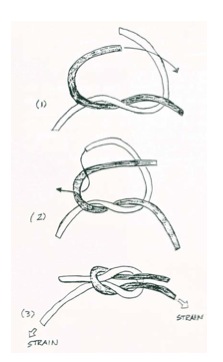4 Knots Every Sailor Should Know

Sailing and Knotsmanship go hand-in-hand together. Regardless of the size of the vessel, sailors rely on lines and knots to perform a variety of functions including everything from securing an anchor to hoisting a sail. Knots themselves come in a variety of shapes, sizes, and difficulties. There are, however, four knots that every sailor should know: The Square Knot, the Cleat Hitch, the Clove Hitch, and the Bowline. This blog will take a brief look at the history, the usage, and how to tie each of these useful knots.
Before diving into these four knots, there are some quick definitions to become familiar with.
- A rope is purchased as a rope, but once it is in use aboard it is called a line
- the standing part is the part of the rope that comes under load or strain
- the working end or free end is the part furthest from the part of the rope that is under load and is often the portion we use to tie knots
- a bight is the general name for an open curve in a line of rope
- a loop is a closed curve in a line of rope
SQUARE KNOT

To tie a Square Knot, first make a simple overhand knot (1), and note which of the ropes is uppermost (dark colored line). To Form the second overhand knot, lay the uppermost end (dark) over the other and pass the other through the eye formed (2). The finished knot should look symmetrical (3). Be careful not to tie a ‘granny knot’ which does not look symmetrical! Just remember ‘right over left, twist, left over right twist’.
CLEAT HITCH

To cleat a line, first start with a turn around the base of the cleat. Done correctly, the first turn should begin on the near-side of the cleat and extend around the far end, opposite of the load. Bring the line over the front face of the cleat (1) below each horn in turn, in a figure-eight pattern (2), and back underneath the crossing turn as shown (3&4). It can take some practice to figure out the proper finishing twist, but a correct cleat hitch should look like a ‘bridge over two rivers’ and have at least 4 feet of excess working end.
CLOVE HITCH

To tie a clove hitch, take a turn around the fitting to which you intend to secure the line. As the free end completes the first round turn, lead the line under the standing end (1) and make another round-turn, crossing over the first (2). The free end should be ed through the eye of the second turn (2). To check your progress at this point, make sure that the two ends point in opposite directions (3) Secure the hitch by pulling from both sides. Be careful not to make the free end too short, as it may slip under tension.
BOWLINE

To tie a bowline, form an eye toward the end of the rope, but far enough away to give you a loop the size you require (1). In the eye, the standing part should be underneath. Lead the free end underneath and through the eye (2). Then take a turn round the standing part and push the end back through the eye again (3). Tighten the knot by holding the standing part in one hand, the free end in the other and pulling (4)
When learning, this fun story about the rabbit might help you out. Imagine the end of the rope as a rabbit, and where the knot will begin on the standing part, a tree trunk. First a loop is made which represents the rabbits hole. The rabbit, or working end, then comes out of the hole, around the tree, then back down the hole.
Hope you enjoyed the first installment of our how-to tie knots series, look for more in the upcoming weeks. If there’s a specific knot that you want to learn how to tie, let me know and I’ll work it in sooner rather than later!
